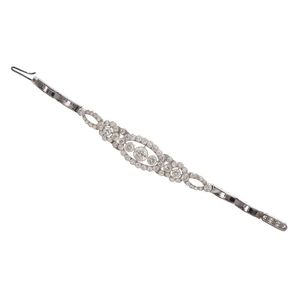Art Deco Diamond Cocktail Watch with Platinum & 10ct Bracelet
You must be a subscriber, and be logged in to view price and dealer details.
Subscribe Now to view actual auction price for this item
When you subscribe, you have the option of setting the currency in which to display prices to $Au, $US, $NZ or Stg.
- Art Deco Period - The Art Deco period was a cultural movement that emerged in the 1920s and 1930s, and was characterized by its emphasis on modernism, luxury, and elegance. The name "Art Deco" comes from the Exposition Internationale des Arts Décoratifs et Industriels Modernes, a large exhibition held in Paris in 1925 that showcased the latest trends in decorative arts.
Art Deco was a reaction against the ornate and elaborate styles of the previous era, and reflected a new modern sensibility. It was characterized by streamlined, geometric shapes, bright colours, and the use of new materials such as chrome, glass, and Bakelite. Art Deco designers sought to create a sense of luxury and sophistication, often incorporating expensive materials such as ivory, marble, and rare woods.
Art Deco had a significant impact on a wide range of artistic fields, including architecture, fashion, graphic design, and interior design. Some of the most iconic examples of Art Deco architecture include the Empire State Building in New York City, the Hoover Building in London, and the Palais de Chaillot in Paris.
The Art Deco period came to an end in the 1940s, as World War II and changing cultural trends led to a shift in artistic styles. However, Art Deco remains an important influence on design and art, and continues to be celebrated for its modernist sensibility and glamorous aesthetic. - Circa - A Latin term meaning 'about', often used in the antique trade to give an approximate date for the piece, usually considered to be five years on either side of the circa year. Thus, circa 1900 means the piece was made about 1900, probably between 1895 and 1905. The expression is sometimes abbreviated to c.1900.
- Bezel - On a clock or watch, the bezel is the metal frame into which the watch or clock glass is fitted. In clocks, the bezel may include a hinge and a flange, in effect a door to the face of the clock. In jewellery the bezel is a band of metal with a projecting lip that holds the gemstone in its setting.
- Movement - The technical name for the workings of a clock or watch, and does not include the dial or case.
This item has been included into following indexes:
Visually similar items

An Art Deco style ruby and diamond bracelet, of geometric design set throughout with carre cut rubies and round brilliant cut diamonds, mounted in 18ct white gold, total length 165 mm.

An Art Deco diamond bracelet, the open style floral setting, centrally set with a tranisition cut diamond of of 1.48cts, flanked and detailed throuout with further tranisition and old cut diamonds totalling 4.14cts, mounted in platinum to a Britannia link

An Art Deco style diamond bracelet, comprising a series of diamond set millegrain panels totalling 1.75cts, mounted in 18ct white gold, total length 180 mm.

A ladies Art Deco diamond wristwatch, manual wind movement, rectangular silvered dial with black Arabic numerals, platinum case with diamond set bezel and lugs, to platinum expandable bands, total length 165 mm, case length 22 mm. Condition: Not ticking wh
